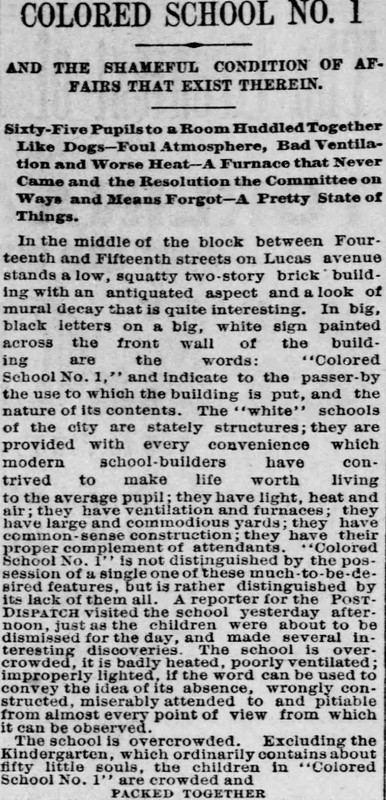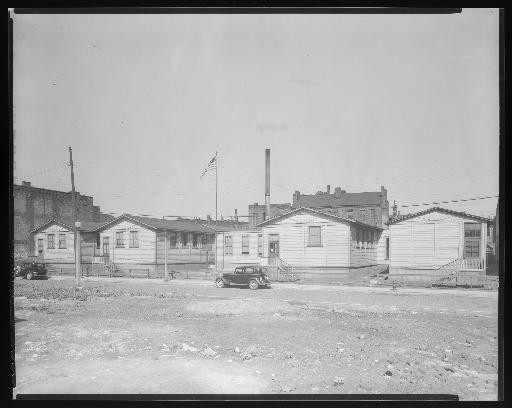Colored School No. 1, Dumas Elementary
Introduction
Text-to-speech Audio
Images
Description of the horrid conditions students and faculty faced at Colored School No. 1

Dumas Elementary ca. 1936 after another move at 1241 South Third Street

Backstory and Context
Text-to-speech Audio
The story of Colored School No. 1 goes back to the end of the Civil War. During the Civil War, both free and enslaved African Americans had limited opportunities to receive an education. Slave states felt that an educated enslaved person was more dangerous; they believed that a literate slave could read abolitionist papers and write to other enslaved people to encourage them to rise up against their owner. In St. Louis during the Civil War, roughly 1600 African Americans attended five schools directed by the Sanitary Commission, an organization which provided food, clothing, medical attention, and other basic needs to the populations of war torn areas. However, after the end of the Civil War and the emancipation of enslaved African Americans, the government required in the new Constitution that public schools provide education to all students. The St. Louis Board of Education began operating the African American schools in 1865. By 1866, the Board had consolidated the Sanitary Commission schools, and opened the first of what would eventually be twelve schools for African Americans.
Both students and faculty alike faced a great deal of hardship in the early days of post-Civil War education. It became apparent that politicians in charge of the city and school board, along with a significant portion of the white population, intended only to fulfill the bare minimum of requirements set forth by the new Constitution. The Superintendent reported in the late 1860s that the Board of Education and government had no policies in place to enforce the standards set for the new schooling system. The Board of Education only rented buildings for the African American schools. These tended to be small residential facilities, forcing classes of fifty to be crammed into singular rooms. Colored School No. 1 originally sat at Gratiot and Fifth Street in a two story, four room structure that had 4 teachers for roughly 200 students. The animosity towards the African American community also meant that the African American schools had a difficult time filling faculty positions, since white teachers did not want to teach in the school, or train African American teachers. In addition to limited access to resources, the members of the African American school district faced the threat of violence as well. In 1868 for instance, a drunken police officer assaulted a faculty member of Colored School No. 2 simply due to the teacher's race and profession of supporting young African Americans.
The hardships continued to the members of the African American district schools. Since they attended school in rented facilities, the students dealt with uncertainty, as they did not know how long they would be in one spot, and possibly fearing if they'd be able to attend their school after it relocated. By 1880, Colored School No. 1 had moved to its location at 1413 Lucas Avenue, by the modern day City Museum and Enterprise Center. This property had an estimated value of $34,293 in 1880, roughly $919,000 in modern money. Meanwhile, some of the white schools had property values of $76,499, or nearly $2 million today. This low-value accommodation showed in the slew of issues the students and faculty faced. According to the St. Louis Post-Dispatch and St. Louis Globe Democrat, the school board knew the new location lacked ventilation, heating, and air condition starting in 1880. The newspaper ran a full account of these poor conditions in 1886, but the Board of Education did not award a contract to fix the problem until four years later in 1890. Not only did the students suffer, but adults as well. Colored School No. 1 began a night school in 1888, but the right of adults to attend school was taken away. The school board appeared to want the African American community to feel lesser than the white population. While white schools were named after famous and prominent people, African American schools were only given numerical identifiers, giving them a cold, inhuman feeling. The disregard for African American quality of education left the community feeling like second-class citizens.
However, despite the hardships they faced, students continued to resist the hatred forced upon them, prove their academic prowess and equality, and demonstrate their civil pride. Receiving and excelling at education in itself was a symbol of opposition in the late nineteenth century. During the years of enslavement, the law prohibited the education of enslaved people. While secret schools for slaves evolved, few received an education. Now, the African-American proved their academic prowess. In a report by the Board of Education in 1880 showed that the African American district schools had a 91% attendance rate, and had fewer students marked late than the white district schools. Education then, just as it does now, provided African-American students significant opportunities that allowed them the chance to improve the quality of their and their family's lives. The leaders of Colored School No. 1 became leaders of within the community, voicing their support and resistance to oppression. The principal of Colored School No. 1 gave speeches at Emancipation Day programs that supported the African American Community. And in 1888, the students of Colored School No. 1 had a central part in the May Day festivities in the city. Even the name of the school stands as a symbol of resistance. After 1890, Colored School No. 1 was named Dumas Elementary, after the French writer. The students and faculty continued to persevere as a community during the hardships of the Jim Crow Era.
Sources
A Preservation Plan for St. Louis Part I: Historic Contexts. “Reading, Writing and Figuring.” St. Louis Government. Accessed March 24, 2020. https://www.stlouis-mo.gov/government/departments/planning/cultural-resources/preservation-plan/Part-I-African-American-Experience.cfm
St. Louis Public Schools. Sixteenth Annual Report of the Board of Directors of the St. Louis Public Schools for the year ending Aug 1, 1870. St. Louis: Plate, Olshausen and Bindens, 1871
St. Louis Public Schools. Twenty-Sixth Annual Report of the Board of Directors of the St. Louis Public Schools for the year ending Aug 1, 1880. St. Louis: Slawson and Co. Printers, 1881
"Colored School No. 1: And the Shameful Condition of Affairs that Exist Therein" St. Louis Post-Dispatch, January 14, 1886, Accessed March 24, 2020, Newspapers.Com
"Flowers and Song: May Day Beautifully Celebrated by Colored School No. 1." St. Louis Post-Dispatch. May 22, 1888. Accessed March 24, 2020. Newspapers.com
Friedman, Morgan, “Inflation Calculator,” Westegg, Accessed March 25, 2020. https://westegg.com/inflation/
"The School Board, The Regularly Monthly Meeting, Annual Report of the Secretary and Reports of Various Committees-Important Subjects Discussed: Resolutions," St. Louis Globe Democrat, November 10, 1880, Accessed March 24, 2020, Newspapers. Com
Williams, Henry Sullivan, "The Development of Negro Public School Systems," The Journal of Negro History, Vol 5. No. 2 (April 1920): 137-165.
"Schools and Teachers: A Number of Changes and Promotions-Night School Preparations" St. Louis Globe Democrat, October 2, 1888. Accessed March 25, 2020. Newspapers.Com
"A Policeman on a Bender," St. Louis Globe Democrat, January 25, 1868, Accessed March 25, 2020. Newspapers.Com
"Awarded the Contract: The Fuller and Warren Co. Will Heat and Ventilate Colored School No. 1." St. Louis Post-Dispatch, July 27, 1890. Accessed March 25, 2020. Newspapers.Com
"Emancipation Day: Desoto, MO" St. Louis Globe Democrat, August 5, 1888. Accessed March 25, 2020. Newspapers.com
Wright, John A. Discovering African American St. Louis: A Guide to Historic Sites. St. Louis: Missouri Historical Society Press, 2002.
"Colored School No. 1: And the Shameful Condition of Affairs that Exist Therein" St. Louis Post-Dispatch, January 14, 1886, Accessed March 26, 2020, Newspapers.Com
"Dumas School: Portable School Buildings," Missouri Historical Society Digital Collections, Accessed March 26, 2020. https://mohistory.org/collections/item/P0900-17032-01-8n; "Notice to Voters, Whereas a Primary Election will be Held March 10, 1939," St. Louis Globe Democrat, February 28, 1939, Accessed March 26, 2020. Newspapers.com
